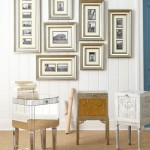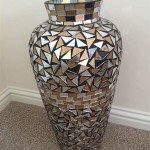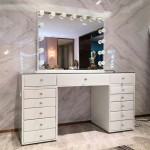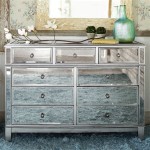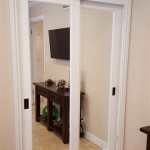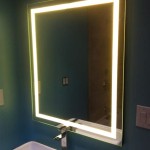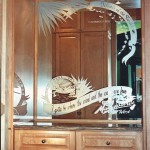How To Reframe A Mirror: A Comprehensive Guide
Reframing a mirror is a cost-effective way to update the aesthetics of a room, personalize décor, or salvage a beloved mirror with a damaged or outdated frame. This process allows for creative expression and can transform a simple reflecting surface into a statement piece. Whether the objective is to match a specific interior design style, conceal imperfections, or simply add a personal touch, reframing a mirror offers a versatile solution.
The process involves several steps, from safely removing the existing frame to selecting a suitable replacement and securely attaching it. Each step requires careful planning and execution to ensure a professional-looking result and prevent damage to the mirror itself. This article provides a detailed guide to reframing a mirror, covering the necessary tools, materials, and techniques.
1. Preparation and Dismantling of the Existing Frame
Prior to commencing the reframing process, adequate preparation is crucial. This begins with selecting a suitable workspace. A flat, stable surface covered with a protective material, such as a drop cloth or cardboard, is recommended. This will prevent scratches or damage to the mirror surface during handling. Furthermore, ensuring sufficient lighting will aid in accurate execution of each step.
The next step involves gathering the necessary tools and materials. These typically include: a flathead screwdriver, a utility knife, safety glasses, gloves, a measuring tape, a new frame (pre-made or custom-built), wood glue (if necessary), brad nails or similar fasteners, a brad nailer (if using brad nails), clamps, and cleaning supplies (glass cleaner and a soft cloth). Having all materials readily available streamlines the process and minimizes interruptions.
The actual dismantling of the existing frame requires caution and precision. The method for removal will vary depending on how the frame is attached. Common attachment methods include: clips, screws, nails, or adhesive. Begin by carefully inspecting the frame to identify the method of attachment. If screws are present, use a screwdriver to remove them. For clips, gently pry them open using a flathead screwdriver. If the frame is attached with nails, carefully use a nail punch and hammer to drive them out from the back. When adhesive is used, gently use a utility knife to score along the edges of the frame to loosen the adhesive bond. It may be necessary to carefully wedge a thin, flat object, such as a putty knife, between the frame and the mirror to separate them. Apply steady, even pressure to avoid cracking or shattering the mirror.
Once the frame is detached, thoroughly clean the edges of the mirror to remove any remaining adhesive, debris, or old caulk. Use a glass cleaner and a soft cloth to ensure a clean surface for attaching the new frame. Dispose of the old frame responsibly.
2. Selecting and Preparing the New Frame
Choosing the appropriate frame is a critical step in the reframing process. The selection should be guided by several factors, including: the desired aesthetic, the dimensions of the mirror, the existing décor of the room, and the budget. Pre-made frames are readily available in various sizes, materials, and styles at home improvement stores and framing shops. Alternatively, a custom-built frame can be ordered from a framing professional or constructed at home using wood or other materials.
When selecting a pre-made frame, ensure that the inner dimensions accurately match the outer dimensions of the mirror. A frame that is too small will not fit, while a frame that is too large will leave an unsightly gap. Carefully measure the mirror's dimensions (length and width) to ensure a precise fit. Consider the desired style of the frame. Options range from simple and modern to ornate and traditional. The choice should complement the overall aesthetic of the room where the mirror will be displayed.
If opting for a custom-built frame, precise measurements are even more crucial. Accurately measure the mirror's dimensions and add additional allowance for the rabbet (the recess on the back of the frame that holds the mirror). The rabbet depth should be sufficient to accommodate the thickness of the mirror and any backing board that may be used. Choose the desired material for the frame. Wood is a popular choice due to its versatility and aesthetic appeal. Other options include metal, plastic, or composite materials. If using wood, select a suitable type based on its grain, color, and durability. Common wood types include pine, oak, and maple.
Once the frame is selected or constructed, it may require preparation before attaching it to the mirror. This may involve sanding, staining, painting, or applying a sealant. If applying a finish, ensure that it is fully dry before proceeding to the next step. This will prevent smudging or damage to the finish during installation.
3. Attaching the New Frame to the Mirror
The method for attaching the new frame to the mirror will depend on the type of frame and the desired level of permanence. Several options are available, each with its own advantages and disadvantages. These options include: clips, brackets, adhesive, or a combination of methods.
Using clips or brackets is a relatively simple and non-permanent method. Metal or plastic clips are attached to the back of the frame and secure the mirror in place. This method allows for easy removal of the mirror from the frame if necessary. Ensure that the clips are properly sized and securely attached to the frame using screws or nails. Distribute the clips evenly around the perimeter of the mirror to ensure even support.
Adhesive provides a more permanent and seamless attachment. Specialized mirror adhesive is designed to bond to glass without damaging the reflective surface. Apply a thin, even layer of adhesive to the back of the frame, being careful to avoid getting adhesive on the mirror surface. Position the frame onto the mirror, ensuring that it is properly aligned. Apply gentle pressure to the frame to ensure a secure bond. Use clamps to hold the frame in place while the adhesive cures. Follow the manufacturer's instructions for drying time, which is typically 24-48 hours.
Combining adhesive with other methods, such as brad nails, provides an extra layer of security. Apply adhesive as described above, and then use a brad nailer to drive small brad nails through the back of the frame and into the backing board (if present). This will provide additional support and prevent the frame from shifting while the adhesive cures. Ensure that the brad nails are short enough to avoid penetrating the mirror surface.
Regardless of the method chosen, ensure that the frame is securely attached to the mirror before hanging it. Carefully inspect the attachment to ensure that it is stable and will not detach. If necessary, add additional clips, adhesive, or fasteners to reinforce the attachment.
4. Finishing Touches and Installation
Once the frame is securely attached, several finishing touches can enhance the overall appearance and functionality of the reframed mirror. These may include: adding a backing board, installing hanging hardware, and cleaning the mirror surface.
A backing board provides additional support and protection for the mirror. It is typically made of wood or cardboard and is attached to the back of the frame. The backing board helps to prevent the mirror from flexing or breaking and also conceals any gaps or imperfections between the mirror and the frame. Cut the backing board to the size of the frame and secure it to the back using nails, screws, or adhesive.
Installing appropriate hanging hardware is essential for safely and securely mounting the reframed mirror. The type of hardware required will depend on the weight of the mirror and the type of wall it will be mounted on. Common hanging hardware options include: D-rings, wire, and sawtooth hangers. D-rings are attached to the back of the frame and are used in conjunction with picture hooks or screws. Wire is strung between two D-rings and is hung from a hook or nail. Sawtooth hangers are attached directly to the back of the frame and are hung from a nail or screw. Ensure that the hanging hardware is rated to support the weight of the mirror and that it is securely attached to the frame. Use a level to ensure that the mirror is hung straight.
Finally, thoroughly clean the mirror surface to remove any fingerprints, smudges, or dust. Use a glass cleaner and a soft cloth to achieve a streak-free finish. Inspect the frame for any imperfections or blemishes and touch up any necessary areas. Once the mirror is clean and the frame is in pristine condition, it is ready to be installed in its designated location.

Reframing A Mirror 5 Unique Ways Müller Designs
Diy Modern Mirror Re Frame What Not To Do Kayla Simone Home
Diy Modern Mirror Re Frame What Not To Do Kayla Simone Home

How To Frame A Mirror Sand And Sisal

How To Make Any Frame Into A Mirror Stonegable

Diy Bathroom Mirror Frame Without Removing Clips Her Happy Home
Frame Large Mirror Diy Project

Iheart Organizing Diy Wood Framed Mirror

Diy Bathroom Mirror Frame For Under 10 O Hayley Blog

How To Frame A Builder Grade Mirror The Turquoise Home
